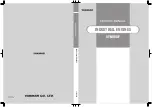
9
LOCKED FOR PRINTING – SELECT SECT. NEEDED >
151
NOTE:
Recondition the cylinder bores to restore the
crosshatch finish whenever new piston
rings are installed to a cylinder that is within
specification. Be careful not to hone the
cylinder oversize or it will be necessary to
resize the cylinder.
Lubricate hone as recommended by hone
manufacturer. The recommended drill speed is
300
– 700 RPM
and
40 - 60 strokes per minute
.
Because cylinder bores normally wear only in the
area of ring travel (3), the cylinder bore will be round
above and below ring travel area,
Fig. 3
(B)
. Start
drill and, as hone spins, move it up and down (7) at
the bottom of the cylinder bore (4). Gradually
increase the length of the strokes until hone travels
full length of cylinder bore (8), but no more than
3/4
– 1” (19 – 25 mm)
above or below (6) cylinder bore,
Fig. 3
(C)
. Lubricate hone frequently to prevent build
up on stones.
As cutting tension decreases, stop hone and tighten
adjusting knob following hone manufacturer’s
recommendations. Check cylinder bore frequently.
Fig. 3
ÓÓÓ
ÓÓ
ÓÓ
ÓÓÓ
ÓÓÓ
ÓÓÓ
ÓÓÓ
ÓÓÓ
ÓÓÓ
ÓÓÓ
ÓÓ
ÓÓ
ÓÓ
ÓÓ
ÓÓ
ÓÓ
ÓÓÓ
ÓÓÓ
ÓÓÓ
ÓÓÓ
ÓÓÓ
ÓÓÓ
ÓÓÓ
ÓÓÓ
ÓÓÓ
ÓÓÓ
ÔÔ
ÔÔ
ÔÔ
ÔÔ
ÔÔ
ÔÔ
ÔÔ
ÔÔ
ÔÔ
ÔÔ
ÔÔ
C
B
A
Finishing
Finishing stones are used after the cylinder bore has
been resized to within
0.0015” (0.04 mm)
of the
desired size or when reconditioning a cylinder bore.
The finishing stones will produce the correct
crosshatch finish necessary for proper lubrication.
The correct crosshatch angle is approximately
45º
(1),
Fig. 4
.
Recondition the cylinder bores to restore the finish
when new piston rings are to be installed in a cylinder
that is within specification. Do not to hone oversize
or it will be necessary to resize the cylinder.
NOTE:
To produce the proper crosshatch finish use
a drill speed of approximately
200 RPM
and
40 - 60 strokes per minute
. Lubricate hone
liberally to prevent build up on finishing
stones.
Fig. 4
Cleaning
CAUTION:
Honing grit is highly abrasive and
will cause rapid wear to all the internal compo-
nents of the engine unless it is completely re-
moved. The entire cylinder and crankcase
MUST be THOROUGHLY cleaned after honing.
First wash the cylinder and crankcase carefully in a
solvent such as kerosene or commercial solvent.
Then thoroughly wash cylinder and crankcase using
a stiff brush with soap and hot water. Rinse
thoroughly with hot running water. Repeat washing
and rinsing until all traces of honing grit are gone.
NOTE:
When cylinder and crankcase have been
thoroughly cleaned, use a clean white rag or
napkin to wipe the cylinder bore. If honing
grit is present it will appear as a gray residue
on rag. If any honing grit is evident, re-wash
and rinse entire cylinder and crankcase and
check again. When there is no trace of
honing grit on rag, the cylinder has been
properly cleaned. Oil the cylinder bore to
prevent rusting.
Содержание OHV V-Twin
Страница 27: ...1 26...
Страница 113: ...4 112...
Страница 156: ...10 155 Section 10 Crankshafts and Camshafts Page INSPECT CAMSHAFT 156 INSPECT CRANKSHAFT 156 INSPECT FLYWHEEL 157...
Страница 159: ...10 158...
Страница 177: ...12 176...
















































